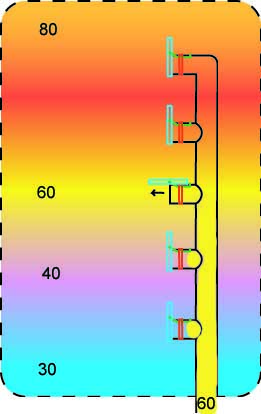
Buying an Aljezur farmhouse
Aljezur farmhouses for sale
Algarve west coast climate; the best weather in Europe?
Contact
Odeceixe beach
Control of the red palm weevil
Vicentina natural park wildlife
Heating options
The truth about coastal property
What is natural park Costa Vicentina?
Building and renovating in western Algarve
Portugal land scams
Fishing on the Vicentina coast
Western Algarve agriculture
AFPOP
Utilities in Portugal
Schools in Aljezur
Solar home heating plans
How to build a DIY Stratified heat storage tank for solar home heating
DIY stratifier tube, stratification tube, stratification valve
My idea is to have a big tank, big enough to store heat for several days, maybe a week.
However, these plans can be scaled down for a smaller tank too.
I calculate I need a ton of water per day of stored heat.
There are online resources to calculate the heat loss of your house, or you could just observe how much fuel you use through the winter.
The amount of usable heat stored in water depends on how high a temperature you can achieve during heating hours, and how low a temperature will still conduct usable heat into your house. The bigger this spread, the more heat each ton of water will hold for you.
Difficulties are;
The large size and weight of a useful tank [around 5 tons for me]. It's too big to come through a standard door, you'll probably want to keep it outside; with insulation and weather proof cladding, that adds a lot of work and expense.
The expense; I suggest using a scrap steel tank. The best would be a used LPG tank; they're strong enough to hold a little pressure easily, are thick enough to weld easily, and are taken out of service when there's still a lot of metal left. I've found a pile of them in southern Portugal.
A pressurized tank can be run as a sealed system [standard practice in central heating], which avoids corrosion problems, I plan a tank around 0.8M diameter and 3M high, with 10 or 20 cm of insulation.
of course there are many suitable materials, it depends what you can find, and what you know how to work with. Sometimes stainless steel tanks can be obtained from industrial auctions or companies that deal in second hand barrels and tanks. Just look out for nasty chemicals, that can be dangerous.
The stratifier tube; Click here for how to fabricate one
First, a short primer on stratification in heat storage tanks.
There have been a lot of studies, both theoretical [PhD thesis's mainly], and practical. All authorities agree, a stratified storage tank is essential to get enough efficiency for a combined [domestic hot water / home heating] system to work.
What it is; Stratification is basically hot layers above, and cold below. As heat is added, the cold water is pulled away from the bottom of the tank, and hot water fed into the middle or top. The important thing is to stop the tank from mixing, and to let the heated water into the correct level of the tank.
The stratification tube is what introduces heat into the tank. Here's the clever part; the incoming hot water should be directed into the tank at the level where the temperature is the same as the incoming water. Cold water is removed from the bottom, and the warm layer slowly moves down. Hot water will be at the top of the tank, and be used mostly for Domestic Hot Water [dhw]. The middle of the tank, at 40°-60° will be used for home heating.
When you get strong sun, 80°-90° water will be produced, and sent to the top of the tank.

Let's say your solar collector output is at 60C. It will rise past the lower flaps, since the higher density cooler water on the other side holds them closed. It will not rise into the hotter water above, since the entering 60° water is denser and heavier than it. It will push open the flap at the point in the tank where there is the least resistance, which is at the point of equal density and temperature.
The water in the tube above the open valve will heat up through the tube walls.
The flaps should open with not more than a couple of grams of pressure, and fall closed by gravity. They don't need to seal perfectly, as at the ultra low pressure difference against them, little water will leak through. The important thing is that they don't stick, and move freely, even after years in the water. It will be hard to tell if something isn't working right, and even harder to fix.
The tank should have an access door for maintenance.
The artwork is mine, but the principle of operation is well known and proven.
This system works best with a glycol mixture, as glycol changes density with temperature more than plain water does; but for a big tank like this, glycol is too expensive. Therefore, make the tank as tall as possible, preferably 3 meters [10 feet]. The extra height equals extra stratification.
Next; how to draw the temperature of water you want from the level it is in the tank at any given moment. click here